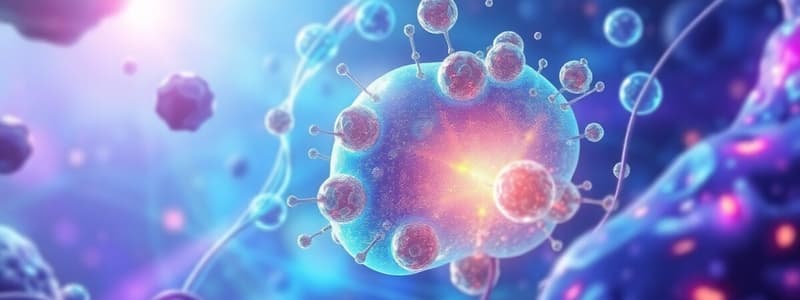Podcast
Questions and Answers
Which of the following accurately describes the function of the cell membrane?
Which of the following accurately describes the function of the cell membrane?
- It stores genetic information.
- It controls the movement of substances in and out of the cell. (correct)
- It produces energy for the cell.
- It packages proteins for export.
What is the correct sequence of the stages of mitosis?
What is the correct sequence of the stages of mitosis?
- Telophase, anaphase, prophase, metaphase
- Prophase, metaphase, telophase, anaphase
- Metaphase, prophase, anaphase, telophase
- Prophase, metaphase, anaphase, telophase (correct)
Which of the following body systems is responsible for transporting nutrients and oxygen throughout the body?
Which of the following body systems is responsible for transporting nutrients and oxygen throughout the body?
- Digestive system
- Circulatory system (correct)
- Respiratory system
- Excretory system
What are the prefixes in the metric system that represent 100 and 1000 respectively?
What are the prefixes in the metric system that represent 100 and 1000 respectively?
What is the main function of a flower in a flowering plant?
What is the main function of a flower in a flowering plant?
Which of the following cells in the retina are responsible for color vision?
Which of the following cells in the retina are responsible for color vision?
How does asexual reproduction in plants differ from sexual reproduction?
How does asexual reproduction in plants differ from sexual reproduction?
What defines the central nervous system?
What defines the central nervous system?
Which of the following tools is primarily used to measure temperature?
Which of the following tools is primarily used to measure temperature?
What type of genetic mutation involves the addition of one or more nucleotide base pairs into a DNA sequence?
What type of genetic mutation involves the addition of one or more nucleotide base pairs into a DNA sequence?
Which term refers to the process where organisms with traits that better suit their environment tend to survive and reproduce?
Which term refers to the process where organisms with traits that better suit their environment tend to survive and reproduce?
What is a common characteristic of homologous structures in different species?
What is a common characteristic of homologous structures in different species?
Which of the following spheres of Earth includes all living organisms?
Which of the following spheres of Earth includes all living organisms?
What is the primary method that conservation scientists use to address damage caused by deforestation?
What is the primary method that conservation scientists use to address damage caused by deforestation?
Which of the following best describes the process of energy conversion from stored energy to motion?
Which of the following best describes the process of energy conversion from stored energy to motion?
What type of resource is primarily extracted from hydrothermal vents?
What type of resource is primarily extracted from hydrothermal vents?
Flashcards
Metric system prefixes
Metric system prefixes
Kilo (1000), Hecto (100), Deka (10), Deci (0.1), Centi (0.01), Milli (0.001) are used to represent multiples or subdivisions of a basic unit in the metric system.
Scientific method steps
Scientific method steps
A systematic approach to solving problems: observation, question, hypothesis, experiment, analyze data, draw conclusions, communicate results.
Characteristics of life
Characteristics of life
All living things share these traits: organization, growth, reproduction, adaptation, response to stimuli, homeostasis, and energy.
Cellular organelles
Cellular organelles
Signup and view all the flashcards
Flowering plant life cycle
Flowering plant life cycle
Signup and view all the flashcards
Mitosis stages
Mitosis stages
Signup and view all the flashcards
Photosynthesis product
Photosynthesis product
Signup and view all the flashcards
Central vs. Peripheral Nervous System
Central vs. Peripheral Nervous System
Signup and view all the flashcards
Dominant vs. Recessive
Dominant vs. Recessive
Signup and view all the flashcards
Homozygous vs. Heterozygous
Homozygous vs. Heterozygous
Signup and view all the flashcards
What is a Genetic Mutation?
What is a Genetic Mutation?
Signup and view all the flashcards
Drug-Resistant Bacteria
Drug-Resistant Bacteria
Signup and view all the flashcards
What are Adaptations?
What are Adaptations?
Signup and view all the flashcards
How are Fossils Formed?
How are Fossils Formed?
Signup and view all the flashcards
Compounds vs. Mixtures
Compounds vs. Mixtures
Signup and view all the flashcards
Earthquakes and Epicenters
Earthquakes and Epicenters
Signup and view all the flashcards
Study Notes
Metric Prefixes
- Kilo (k): 1,000
- Hecto (h): 100
- Deka (da): 10
- Deci (d): 0.1
- Centi (c): 0.01
- Milli (m): 0.001
Conversions
- 1 centimeter = 10 millimeters
- Ratio for conversion from cm to mm: 10 mm / 1 cm
- To convert 4 cm to mm, multiply: 4 cm * 10 mm/cm = 40 mm
Scientific Method Steps
- Make observations
- Ask questions
- Construct a hypothesis
- Test hypothesis with an experiment
- Analyze results
- Conclude findings
- Communicate results
- Repeat the process if needed
Characteristics of Life
- The document asks for the characteristics of life and shared characteristics of living things.
Levels of Organization in Living Things
- The document asks for naming the levels of organization in living things from cell to organism.
Cell Parts/Organelles
- The document asks to describe what common objects represent parts of a cell. (Diagram included to help)
- The image provides a diagram of a cell and labels various parts.
Cell Functions
- The document asks for functions of the parts of a cell from the diagram
Body Systems
- The image provides diagrams for the circulatory, nervous, respiratory, digestive, skeletal, and muscular systems
- Digestive system function: The digestive system can be used to discuss constipation.
- Other systems are listed for review.
Life Cycles
- The document asks for descriptions of life cycles for specified organisms. Example: Flowering plants, Insects
Mitosis Stages
- The image provides a diagram of the stages of mitosis.
- Telophase, anaphase, prophase, and metaphase are the stages for review.
Asexual and Sexual Reproduction
- The document asks for the difference between asexual and sexual reproduction through examples.
Flower Function
- The document asks for the role/job of the flower within a flowering plant.
Photosynthesis
- The image provides a diagram for the process of photosynthesis.
- Includes inputs like water, carbon dioxide, and light energy; and outputs like oxygen and glucose.
- Also shows wavelengths (colors) of light that plants absorb during photosynthesis
Strategies for Offspring Survival
- The document asks for survival strategies of living things to ensure offspring survival
Sense Organs/Vision
- The document asks about sense organs like the eye, how they function visually, and different receptors.
- The eye uses different cell types for color/black and white vision.
Sense Organ/Smell
- The document asks for the name of the receptors that detect smell/sense smell in the nose.
Nervous System Divisions
- The document asks about the central and peripheral nervous system.
Respiration vs. Fermentation
- The document asks about the differences between cellular respiration and fermentation
- fermentation takes place when oxygen is low.
- Different types of fermentation are discussed
Nutrition Facts
- The document provides sample nutrition label data with percentages of daily values.
- It shows information to perform calculations of percentages.
Enzymes
- The document provides definitions for enzyme, substrate, complex, and lock-and-key mechanism.
Studying That Suits You
Use AI to generate personalized quizzes and flashcards to suit your learning preferences.



